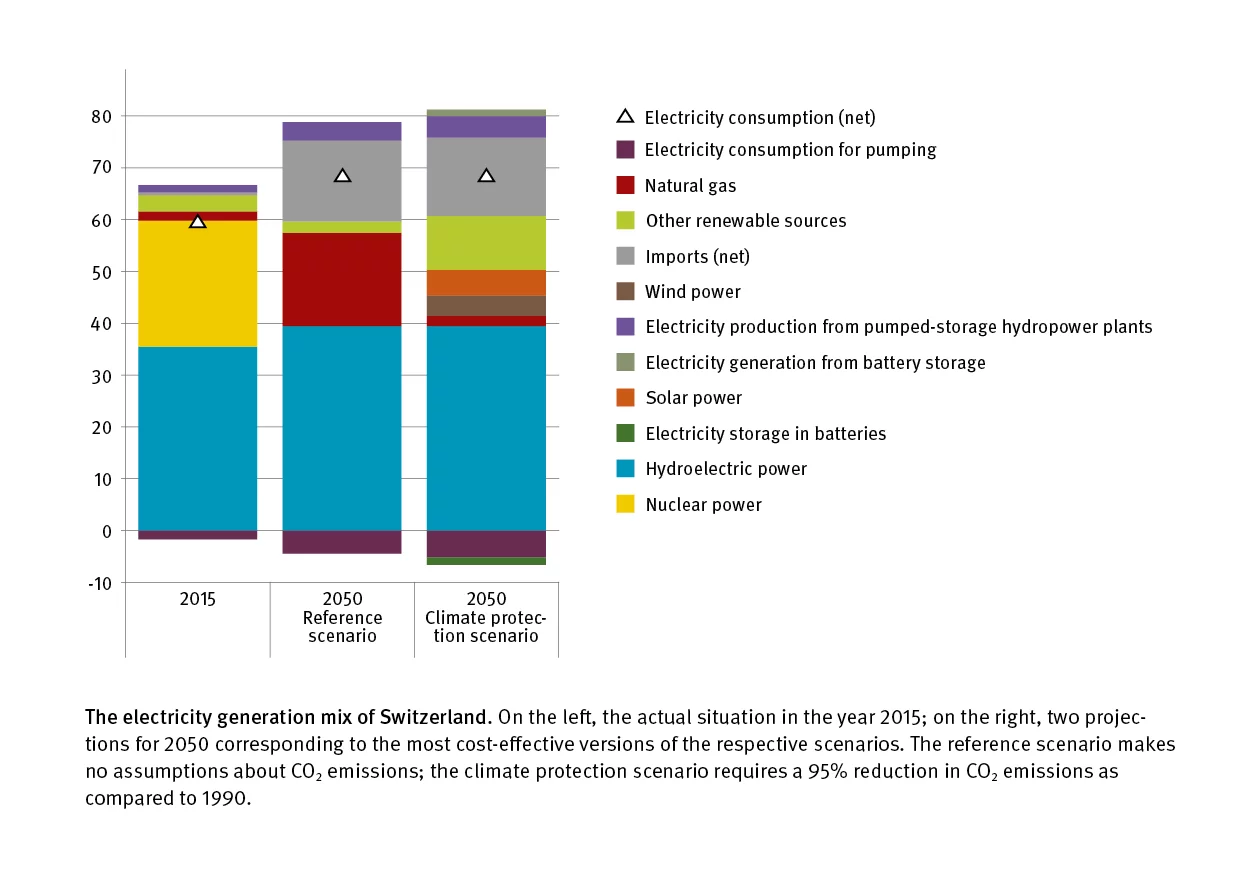The Laboratory for Energy Systems Analysis at the Paul Scherrer Institute PSI is investigating how Switzerland’s electricity supply might look, up to the year 2050, under a variety of boundary conditions. On the basis of their calculations, the lab’s researchers are able to generate insights on possible future developments of the energy sector, for example, determine how an ambitious reduction in CO2 emissions could be achieved at the lowest possible cost.
The Laboratory for Energy Systems Analysis at the Paul Scherrer Institute PSI is investigating how Switzerland’s electric power supply might look, up to the year 2050, under a variety of boundary conditions. The researchers use computer based energy models for this purpose. Their calculations show which technologies could be competitive in the future, what impact they would have on the economy and the environment, and how a reliable supply of electric power could be achieved after the phase out of the current Swiss nuclear power plants.
A multitude of possibilities
In our European electricity model, we have considered more than 800,000 variables
, explains Kannan Ramachandran, a senior scientist in the Energy Economics Group. This includes, for example, the availability of various energy sources and a number of different power plant technologies, together with their future emissions and costs. The anticipated development of power demand in Switzerland is taken into account, as well as the electricity yield from solar and wind power, which is highly variable over the course of the day and from season to season and also differs from region to region.
In 2015, Switzerland’s electricity generation mix consisted of one-third nuclear power and nearly two-thirds hydroelectric power. Only 2.6 percent was generated by other renewable sources such as wind and solar power and 4 percent from other sources such as solid waste.
From this starting point, PSI has now analysed various scenarios for the period until 2050. For each scenario, the researchers applied different constraints to the situation in 2050. In this way they analysed, for each case, how the CO2 emissions should be reduced in comparison to 1990 and, in addition, addressed the implications of self-sufficient Swiss electricity supply versus coordination with the European electricity supply system.
Integration is cost-effective
The calculations allow Stefan Hirschberg, head of the Laboratory for Energy Systems Analysis, to draw conclusions about possible future developments and to determine, for example, how an ambitious reduction in CO2 emissions could be achieved at the lowest possible cost. It would be most cost-effective for Switzerland to be highly integrated into the European electricity system.
That way, the resources would be best utilised. It is clearly easier to achieve the climate goal through a collaborative effort
, he adds. Because of regional differences in resource availability, it would for example be advantageous to place a larger portion of the investment in solar power in southern European countries and to build wind power plants at the North Sea, where the wind conditions are better than in Switzerland. In parallel to this, Switzerland would intensify its effort to develop necessary storage technologies.
With or without the goal of protecting the climate, electricity production will become more expensive than today. In 2050, the production cost per kilowatt hour of electricity in Switzerland will be 20 to 120 percent higher than today, with cost rising with greater levels of CO2 reduction. The costs, though, vary strongly according to whether Switzerland wants to coordinate its investments with the EU countries — which would be considerably less expensive — or to pursue a self-sufficient power system
, Hirschberg explains.
Important storage technologies
The analysis also shows the value of storage technologies. For a power system with a large share of solar and wind energy, the capacity for temporary storage of electricity would have to be more than double what it is today, since these energy sources are not available continuously. Storage during the course of a day as well as between seasons will then become necessary. If Switzerland wants to avoid larger electricity imports in the winter, inter-seasonal storage amounting to two to three terawatt hours would be required — that is, around 40 to 60 times the capacity available today in Switzerland’s pumped-storage hydroelectric plants. In this context, Hirschberg points to the intensive research on this topic at PSI: Among other things, the Energy System Integration Platform serves to test and refine new chemical storage technologies.
The costs for the most cost-effective version differ between the scenarios and between the different variants of each scenario. Thus, the climate protection scenario results in Europe-wide costs 10 percent higher than the reference scenario; this corresponds to additional costs for Europe , of 1800 billion Swiss francs up to the year 2050. Switzerland would bear 36 billion Swiss francs of this cost — assuming it would be fully integrated into the European market. If Switzerland wants to produce its electricity entirely on its own and in a manner that is nearly CO2-neutral, this would cost it an additional 71 billion Swiss francs for the period up to 2050. In short: Climate protection would cost Switzerland around twice as much if it chooses to go it alone.
Text: Alexandra von Ascheraden
Contact
Dr. Stefan HirschbergHead of the Laboratory for Energy Systems Analysis, Paul Scherrer Institute, 5232 Villigen PSI, Switzerland
Telephone: +41 56 310 29 56, e-mail: stefan.hirschberg@psi.ch
Original Publication
Alternative low-carbon electricity pathways in Switzerland and its neighbouring countries under a nuclear phase-out scenarioRajesh Pattupara and Kannan Ramachandran,
Applied Energy 172, 152–168 (2016)
DOI: 10.1016/j.apenergy.2016.03.084


